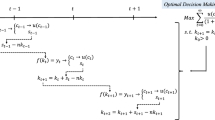Abstract
We investigate the classical Ramsey problem of economic growth when the planner uses non-constant discounting. It is well-known that this leads to time inconsistency, so that optimal strategies are no longer implementable. We then define equilibrium strategies to be such that unilateral deviations occurring during a small time interval are penalized. Non-equilibrium strategies are not implementable, so only equilibrium strategies should be considered by a rational planner. We show that there exists such strategies which are (a) smooth, and (b) lead to stationary growth, as in the classical Ramsey model. Finally, we prove an existence and multiplicity result: for logarithmic utility and quasi-exponential discount, there is an interval I such that, for every k in I, there is an equilibrium strategy converging to k. We conclude by giving an example where the planner is led to non-constant discount rates by considerations of intergenerational equity.
Similar content being viewed by others
References
Carr J.: Applications of Centre Manifold Theory. Springer, NY (1981)
Dasgupta P.: On some alternative criteria for justice between generations. J. Public Econ. 3, 405–423 (1974)
Dasgupta P.: On some problems arising from professor Rawls’ conception of distributive justice. Theory Decis. 4, 325–344 (1974)
Ekeland, I., Lazrak, A.: Being Serious About Non-Cmmitment. http://arxiv.org/abs/math/0604264. Accessed 12 April 2006
Ekeland, I., Lazrak, A.: Equilibrium policies when preferences are time inconsistent. http://arxiv.org/abs/0808.3790. Accessed 27 August 2008
Frederick S., Loewenstein G., O’Donoghue T.: Time discounting and time preference: a critical review. J. Econ. Lit. 40, 351–401 (2002)
Harris C., Laibson D.: Dynamic choices of hyperbolic consumers. Econometrica 69, 935–957 (2001)
Karp L.: Global warming and hyperbolic discounting. J. Public Econ. 89, 261–282 (2005)
Karp L.: Non-constant discounting in continuous time. J. Econ. Theory 132, 557–568 (2007)
Karp L., Fuji T.: Numerical analysis of a non-constant pure rate of time preference: a model of climate policy. J. Environ. Econ. Manag. 56, 83–101 (2008)
Karp L., Lee I.H.: Time-consistent policies. J. Econ. Theory 112, 353–364 (2003)
Krusell P., Smith A.: Consumption-savings decisions with quasi-geometric discounting. Econometrica 71(1), 365–375 (2003)
Phelps E.S.: The indeterminacy of game-equilibrium growth. In: Phelps, E.S. (ed.) Altruism, Morality and Economic theory, pp. 87–105. Russell Sage Foundation, New York (1975)
Phelps E.S., Pollak R.A.: On second-best national saving and game-equilibrium growth. Rev. Econ. Stud. 35, 185–199 (1968)
Ramsey F.P.: A mathematical theory of saving. Econ. J. 38(152), 543–559 (1928)
Sumaila U., Walters C.: Intergenerational discounting: a new intuitive approach. Ecol. Econ. 52, 135–142 (2005)
Author information
Authors and Affiliations
Corresponding author
Rights and permissions
About this article
Cite this article
Ekeland, I., Lazrak, A. The golden rule when preferences are time inconsistent. Math Finan Econ 4, 29–55 (2010). https://doi.org/10.1007/s11579-010-0034-x
Received:
Accepted:
Published:
Issue Date:
DOI: https://doi.org/10.1007/s11579-010-0034-x
Keywords
- Time inconsistency
- Markov strategies
- Ramsey models
- Nash equilibria
- Intergenerational equity
- Implicit differential equation




